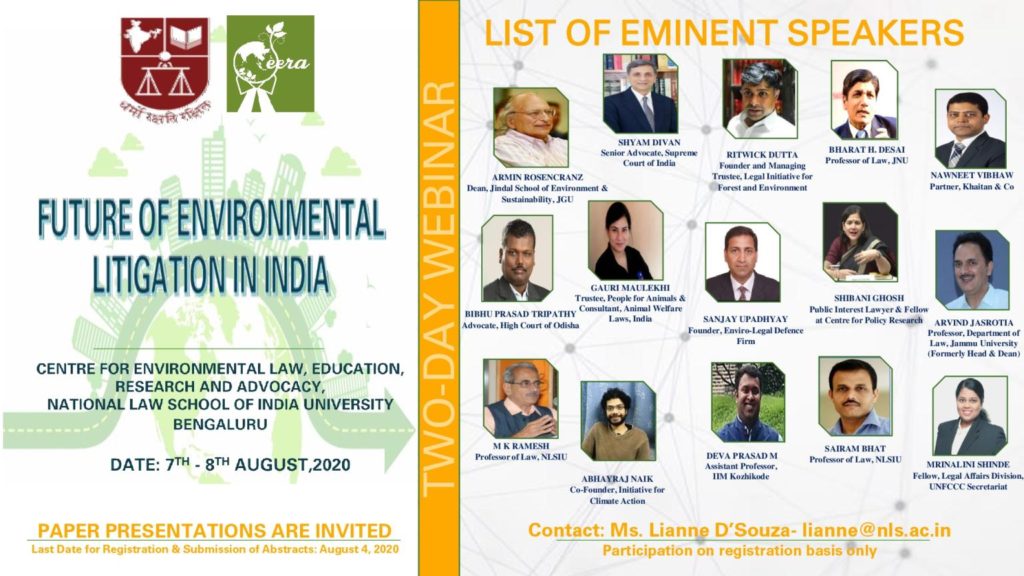TWO-DAY WEBINAR ON “FUTURE OF ENVIRONMENTAL LITIGATION IN INDIA”

TWO-DAY WEBINAR ON “FUTURE OF ENVIRONMENTAL LITIGATION IN INDIA” HOSTED BY CENTRE FOR ENVIRONMENTAL LAW, EDUCATION, RESEARCH AND ADVOCACY (CEERA), NLSIU.
ABOUT THE WEBINAR
In an age when India is witnessing a staggering rise in industrialisation and development, the country is correspondingly facing environmental degradation at a rapid pace. Large scale deforestation, increasing levels of pollution, rise in frequency of natural disasters, rampant depletion of natural resources, extinction of wildlife among many other anthropogenic induced factors are evidence of this deteriorating ecological condition. At the outset, there is no denying that such drastic changes have severe consequences to the natural world.
As the human race also makes up a significant portion of the eco-system, such environmental degradation also poses dire consequences to the lives and well-being of humans, over and above creating a strain on natural environment. In order to deter these damaging consequences from materialising, it is essential that a robust legal system regulating environmentally damaging anthropogenic activities exist. In particular, the presence of a sound judicial system to reinforce these regulations is crucial. Today, there is a plethora of constitutional and legislative provisions on environmental protection in India. In addition to this, over the past few decades, environmental activism and litigation has captured an increased momentum. Several NGO’s, non-state actors, public spirited individuals and members of civil society have taken to courts to vindicate the ‘rights of nature’ by fighting unwarranted attacks on the environment. Parallelly, the National Green Tribunal and the mainstream judiciary have demonstrated the zealous vehemence in combating environmental assaults by enforcing accountability on authorities duty-bound to protect the environment. Besides this, the judiciary has also played a pivotal role by developing and strengthening the environmental jurisprudence in India.
Despite such a robust system in place, there are several challenges to environmental governance in India. From the improper implementation of policies and callousness in enforcing judicial rulings to the lack of expertise and technical know-how amidst the legal fraternity and loopholes in the legislative framework, there are several glaring concerns that underpin the overall legal mechanism. Moreover owing to the dynamic nature of environmental problems, there is a possibility that the institutional structure to ensure environmental protection may not be well-equipped to meet the need of the hour. Therefore, in circumstances such as these, there is a need to reflect on the role of environmental litigation to best address environmental issues. In light of this, the webinar on “The Future ofEnvironmental Litigation in India” aims to understand and analyse the contours of environmental litigation in India and its future prospects as an instrument for achieving environmental justice.
THE WEBINAR HAD INVITE PRESENTATIONS AND PAPERS ON THE FOLLOWING THEMES:
❖ Judicial/Legal Activism in ensuring Environmental Justice
❖ Environmental Justice/ and Public Interest Litigation
❖ Vindication of Rights in Environmental Law (human rights, rights of nature, animal rights)
❖ Intersectional Environmentalism, human rights and health.
❖ Role of adjudicatory Bodies in interpretation and implementation of environmental legislation in India.
❖ Environmental non-compliance and role of the Judiciary
❖ Ex Ante and post facto litigation challenges
❖ NGT: Quasi-Judicial impact assessment.
❖ Environmental Justice and International law
❖ Application of Environmental Justice to combat global challenges
For details regarding the webinar please find the brochure below.
NLSIU-CEERA Brochure for Webinar on Future of Environmental Litigation
The webinar attracted more than 140 participants and over 40 paper presentations. It was successfully hosted by the CEERA team and the report of the proceedings of the webinar is attached below.
REPORT FOR THE TWO DAY WEBINAR

